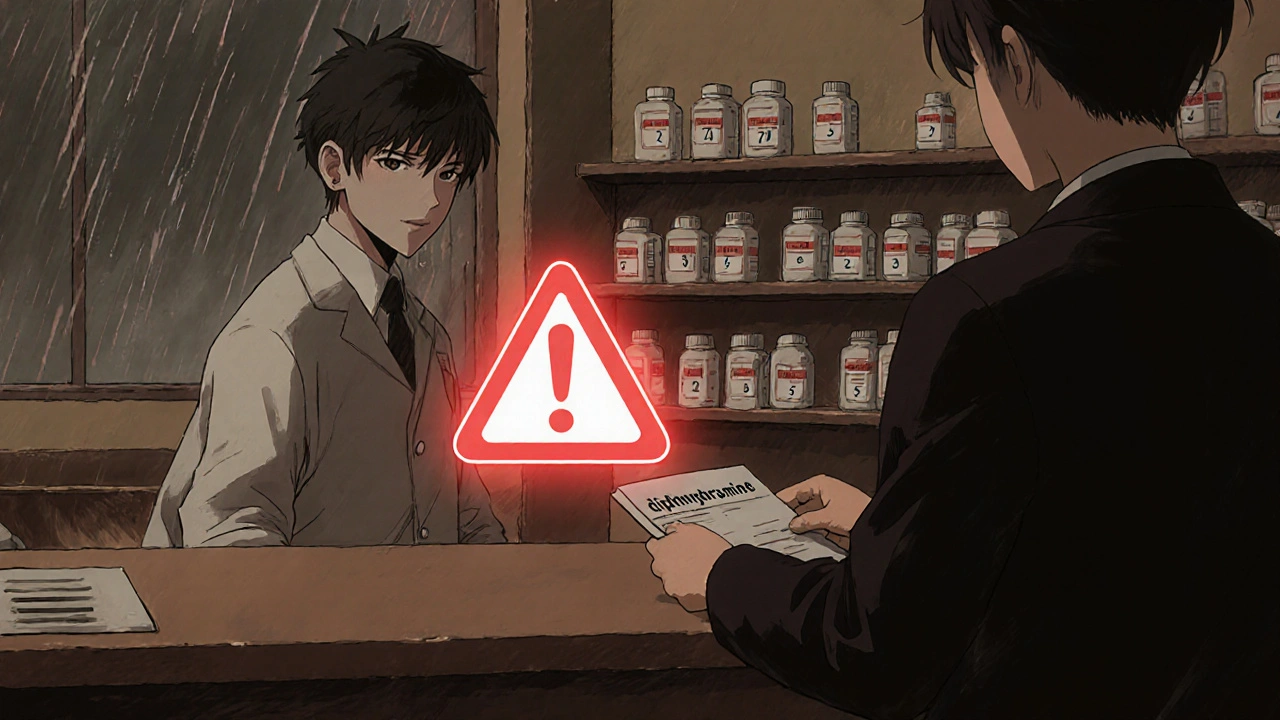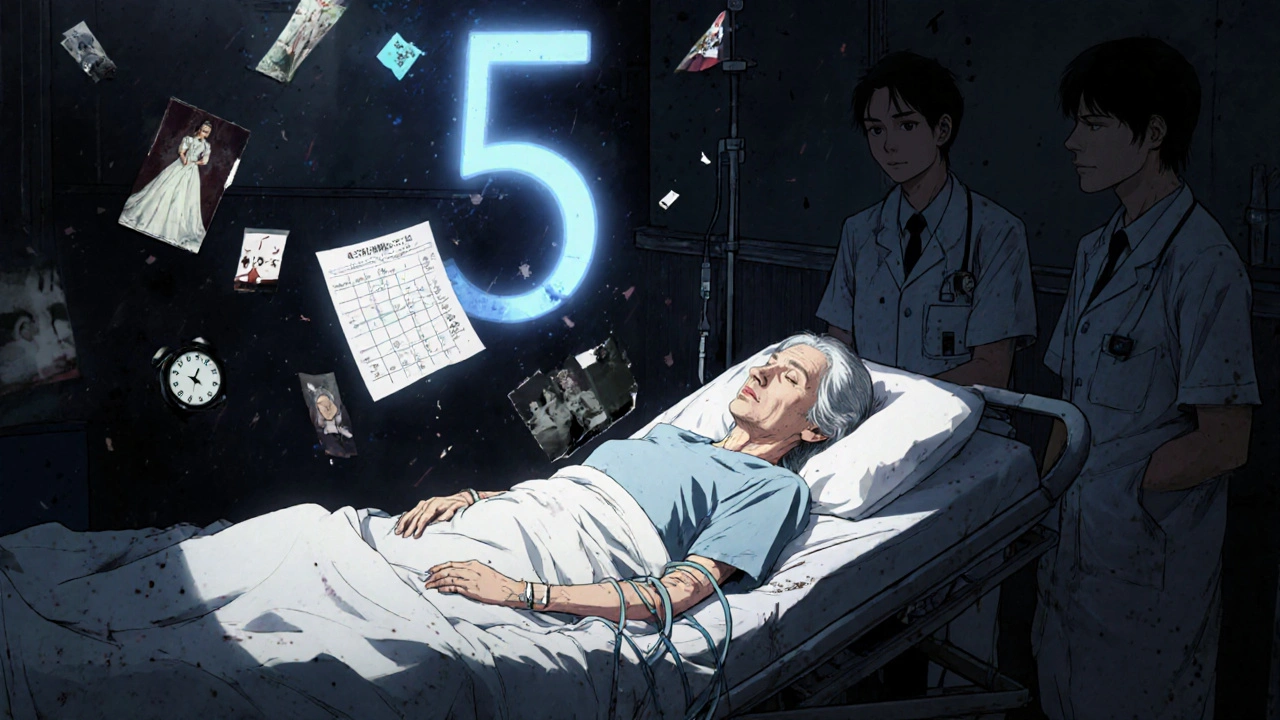Tricyclic Antidepressants and Antihistamines: Why Combining Them Can Cause Anticholinergic Overload
 Nov, 17 2025
Nov, 17 2025
Anticholinergic Burden Calculator
How This Calculator Works
The Anticholinergic Cognitive Burden (ACB) scale rates medications from 0 to 3 based on their anticholinergic effects. A score of 4 or higher doubles dementia risk over time.
Add Your Medications
Your Medications
Total Anticholinergic Burden: 0
Results
Your Total Anticholinergic Burden Score:
0
Score of 4+ doubles dementia risk
What Your Score Means
0-1: Low risk - Minimal anticholinergic effects
2-3: Moderate risk - Possible side effects
4+: High risk - Double dementia risk; seek medical advice
Recommendations
This combination appears safe. Continue with your current medications as prescribed.
It’s not rare to see someone on amitriptyline for nerve pain or depression, and then pick up diphenhydramine (Benadryl) at the pharmacy for allergies or trouble sleeping. On paper, it makes sense. But together, these two drugs can push the body into a dangerous state called anticholinergic overload-a silent, slow-burning crisis that hits hardest in older adults and often goes unnoticed until it’s too late.
What Is Anticholinergic Overload?
Your body uses acetylcholine, a key neurotransmitter, to control everything from muscle movement and digestion to memory and attention. Anticholinergic drugs block this chemical. One drug might block a little. Two? Three? That’s where things go wrong. When multiple anticholinergic medications pile up, they overwhelm the system. The result? Confusion, dry mouth, blurred vision, constipation, urinary retention, rapid heartbeat, and in severe cases, delirium or even seizures.This isn’t theoretical. In 2020, a study published in Elsevier found over 6,800 high-risk drug interaction alerts tied to tricyclic antidepressants (TCAs) and antihistamines in just 3,365 patients. That’s more than two alerts per patient on average. And the most common pairing? Amitriptyline and diphenhydramine.
Why TCAs and First-Gen Antihistamines Are a Dangerous Duo
Tricyclic antidepressants like amitriptyline, clomipramine, and imipramine were developed in the 1950s. They work by boosting serotonin and norepinephrine-but they also strongly block muscarinic receptors, the same ones targeted by anticholinergic drugs. Amitriptyline has a Ki value of 8.9 nM at the M1 receptor, meaning it binds tightly and stays put. That’s why 30-50% of people on TCAs report dry mouth, constipation, or blurry vision.First-generation antihistamines like diphenhydramine, hydroxyzine, and chlorpheniramine were designed to fight allergies by blocking histamine. But they also block acetylcholine receptors-almost as strongly as TCAs. Diphenhydramine’s Ki value is 1,000 nM, which sounds weak, but because people take 25-50 mg at a time (vs. 10-150 mg for TCAs), the total effect adds up fast.
Combine them, and you get an anticholinergic burden that’s more than the sum of its parts. The Anticholinergic Cognitive Burden (ACB) scale rates amitriptyline as a 3 (highest risk) and diphenhydramine as a 2. Together? A score of 5. Research shows that a score of 4 or higher doubles the risk of dementia over time.
Who’s Most at Risk?
Older adults are the most vulnerable. As we age, our liver and kidneys slow down. We metabolize drugs slower. We have fewer acetylcholine receptors to begin with. A 70-year-old on amitriptyline for chronic pain might not realize that their daily Benadryl for allergies is slowly fogging their mind.Dr. David Mischoulon from Massachusetts General Hospital calls this combination one of the most common-but underrecognized-causes of anticholinergic delirium in the elderly. In one case reported on Psych Forums, a patient ended up in the ER with urinary retention and severe confusion after their doctor added Benadryl to their amitriptyline regimen for sleep. The ER team immediately flagged it as anticholinergic toxicity.
It’s not just the elderly. People with Parkinson’s, glaucoma, enlarged prostate, or a history of cognitive issues are also at higher risk. Even younger people can suffer: memory lapses, brain fog, or trouble concentrating after starting this combo are red flags.

What About Other Antidepressants?
Not all antidepressants carry this risk. SSRIs like sertraline (Zoloft) or escitalopram (Lexapro) have minimal anticholinergic effects. Studies show only 5-10% of SSRI users report anticholinergic side effects, compared to 30-50% with TCAs. That’s why TCAs are no longer first-line for depression in most guidelines.But here’s the catch: TCAs are still used-often as first-line-for neuropathic pain, fibromyalgia, and chronic headaches. Their dual action on serotonin and norepinephrine makes them uniquely effective for nerve-related pain. So, they’re not going away. But their use needs to be smarter.
Some TCAs are safer than others. Nortriptyline and desipramine have lower anticholinergic activity than amitriptyline or clomipramine. If you’re on a TCA for pain, ask if switching to nortriptyline could reduce your risk.
What About Antihistamines?
Not all antihistamines are created equal. Second-generation options like loratadine (Claritin), cetirizine (Zyrtec), and fexofenadine (Allegra) have almost zero anticholinergic activity. Their ACB score is 0. They don’t cross the blood-brain barrier like diphenhydramine does. That means they treat allergies without fogging your brain.So if you’re on a TCA and need allergy relief, switch to Claritin or Zyrtec. No trade-off. No added risk. Same relief. Better safety.
And if you’re using diphenhydramine for sleep? That’s a double problem. It’s not just anticholinergic-it’s also a sedative. It masks poor sleep hygiene and can make you dependent. Melatonin (0.5-5 mg) or cognitive behavioral therapy for insomnia (CBT-I) are safer, longer-term solutions.
How to Spot Anticholinergic Overload
The signs are subtle at first. You might think it’s just aging. But here’s what to watch for:- Memory lapses or confusion you didn’t have before
- Difficulty finding words or following conversations
- Dry mouth, constipation, or trouble urinating
- Blurred vision or trouble focusing
- Feeling unusually drowsy or disoriented
- Heart racing or feeling like you might pass out
Doctors use the Mini-Mental State Examination (MMSE) to check for cognitive decline. A score below 24 out of 30 often signals anticholinergic delirium. If you’re on a TCA and an antihistamine and you’re experiencing any of these, it’s not ‘just stress’-it’s a drug interaction.

What Should You Do?
If you’re on a TCA and a first-gen antihistamine:- Don’t stop cold turkey. Talk to your doctor or pharmacist.
- Ask: ‘Is this antihistamine necessary? Could I use Claritin or Zyrtec instead?’
- Request an ACB score calculation for all your medications.
- If you’re over 65, ask if you can be switched to a lower-risk TCA like nortriptyline.
- For sleep, try melatonin or CBT-I instead of Benadryl.
- Ask your pharmacist to run a full medication review-many offer this for free.
Electronic health systems like Epic now block TCA-antihistamine combinations with hard stops. But if your doctor isn’t using one, you might be the only one noticing the risk. Be your own advocate.
The Bigger Picture
This isn’t just about two drugs. It’s about how we prescribe. For decades, we treated symptoms in isolation. Allergies? Give Benadryl. Pain? Give amitriptyline. Sleep? Give diphenhydramine. We didn’t look at the whole picture-the cumulative burden.That’s changing. In 2023, the FDA required updated labeling on all TCAs and first-gen antihistamines to warn about cumulative anticholinergic effects. The American Geriatrics Society’s Beers Criteria now explicitly says: ‘Avoid first-gen antihistamines in older adults taking TCAs.’
And it’s working. A 2023 study showed that when hospitals launched an ‘Anticholinergic Burden Audit,’ they stopped 41% of inappropriate TCA-antihistamine combinations. In one case, a 78-year-old woman had been on amitriptyline, diphenhydramine, and oxybutynin for years. After switching to loratadine and stopping oxybutynin, her MMSE score jumped from 21 to 27 in six months.
Even short-term exposure matters. A 2023 National Institute on Aging study found that just 30 days of high-burden combinations increased delirium risk by 200% in patients over 65. This isn’t a slow, distant threat. It’s happening now.
Final Thought: Knowledge Is Protection
You don’t need to fear your medications. But you do need to understand them. If you’re taking a TCA, don’t assume Benadryl is harmless. If you’re on multiple meds, ask for a full anticholinergic burden check. Ask your pharmacist. Ask your doctor. Write down every pill you take, including OTCs and supplements.Anticholinergic overload doesn’t come with a siren. It creeps in. But once you know the signs, you can stop it before it takes your clarity, your independence, or your memory.
Bailey Sheppard
November 18, 2025 AT 00:21This is one of those posts that should be mandatory reading for anyone over 50 taking multiple meds. I didn’t realize how many OTC sleep aids and allergy pills are quietly eroding cognitive function. Thanks for laying it out so clearly.
Girish Pai
November 18, 2025 AT 11:25Anticholinergic burden is a well-documented pharmacokinetic phenomenon in geriatric polypharmacy. The M1 receptor affinity of amitriptyline (Ki = 8.9 nM) synergizes with diphenhydramine’s CNS penetration, producing a non-linear CYP450-mediated cholinergic deficit. This is not anecdotal-it’s a class effect with Level 1 evidence.